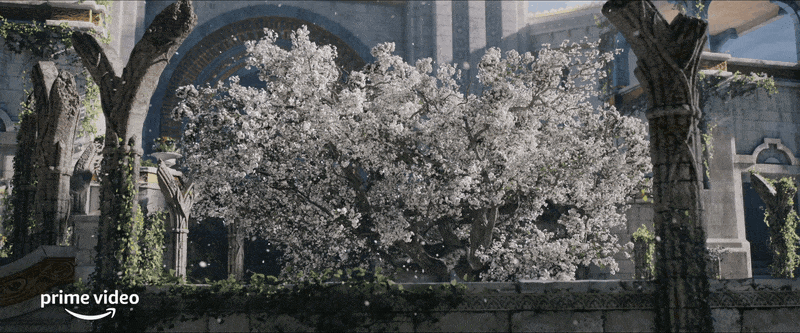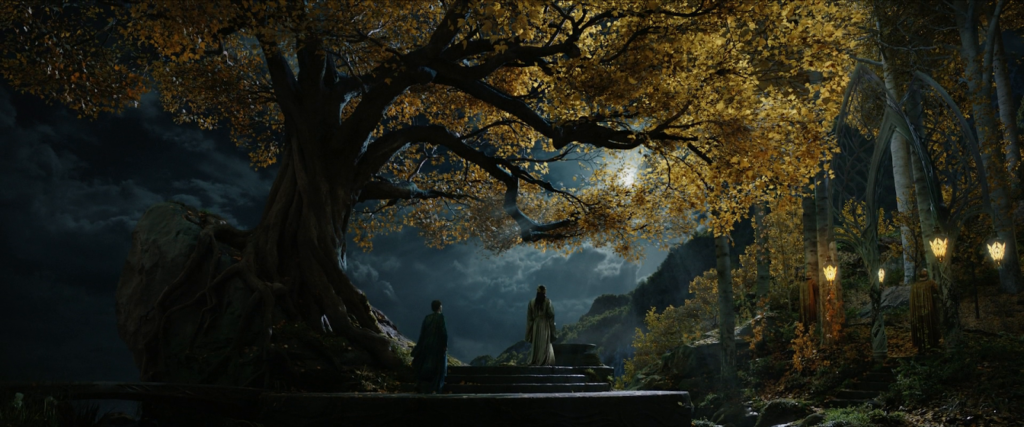In 1967, Tolkien began writing a letter to his son, Michael, where he shared his perspectives on cultivating faith. Tolkien likened the character of faithfulness (‘loyalty’) to that of a full-grown tree — a living organism that must be tended to by its keepers (Letter 306).
While the reasons for this letter may be forever lost to time, the excerpt reveals a fundamental notion in Tolkien’s mind: The symbolism of great faithfulness with the thriving health of trees.
There is no resemblance between the ‘mustard-seed’ and the full-grown tree. For those living in the days of its branching growth the Tree is the thing, for the history of a living thing is pan of its life, and the history of a divine thing is sacred. The wise may know that it began with a seed, but it is vain to try and dig it up, for it no longer exists, and the virtue and powers that it had now reside in the Tree.
Very good: but in husbandry the authorities, the keepers of the Tree, must look after it, according to such wisdom as they possess, prune it, remove cankers, rid it of parasites, and so forth. […] But they will certainly do harm, if they are obsessed with the desire of going back to the seed or even to the first youth of the plant when it was (as they imagine) pretty and unafflicted by evils.
The other motive […] aggiornamento: bringing up to date: that has its own grave dangers, as has been apparent throughout history.
Letter #306, The Letters of J.R.R. Tolkien
In my previous article, we discussed clues from the trailer and images of Amazon’s The Rings of Power that directly led us to identifying Sauron’s haunting presence on Middle-earth. Here, I will discuss how The Rings of Power might be using trees to illustrate the shrinking faith of the Númenoreans (Men) and the Noldor (Elves).
We begin in the island nation of Númenor. The Númenoreans are Men descended from the line of Elros, brother of Elrond. The line of the Kings of Numenor going back to Lúthien, daughter of the Sindarin King Thingol and Melian the Maiar. Of Lúthien’s descendants, Tolkien writes that ‘her line shall never fail’ (A Knife in the Dark, The Fellowship of the Ring).
In the King’s Court at Armenelos, Númenor’s capital, a white tree blooms: Nimloth the fair (Nimloth is Sindarin for ‘White Blossom’). Descended from a tree made in the likeness of Telperion for the Noldor of Tirion (Galathilion, the’White Tree’ of Yavanna, The Silmarillion), Nimloth was gifted as a seedling by the Eldar of Tol Eressëa in Aman. Her white petals gleam with the setting Sun and her scent fills the air of King’s court. Nimloth is the symbol of friendship between Men and Elves. (Cite.) A sign of the Númenor’s faithfulness to Eru and her Elven heritage.
The Númenoreans retained the dedications and order, but altered the fourth day to Aldëa (Orgaladh) with reference to the White Tree only, of which Nimloth that grew in the King’s Court in Númenóreans [my emphasis] was believed to be a descendant.
Appendix D, The Lord of the Rings

The significance of the blooming white tree is not lost to readers of Tolkien. Soon after arriving in Gondor, Aragorn discovers the sapling borne from the fruit of Nimloth. The discovery astonishes Aragorn, but Gandalf recalls the significance of the sapling:
Verily this is a sapling of the line of Nimloth the fair; and that was a seedling of Galathilion, and that a fruit of Telperion of many names, Eldest of Trees. Who shall say how it comes here in the appointed hour? But this is an ancient hallow, and ere the kings failed or the Tree withered in the court, a fruit must have been set here. For it is said that, though the fruit of the Tree comes seldom to ripeness, yet the life within may then lie sleeping through many long years, and none can foretell the time in which it will awake.
The Steward and the King, The Return of the King
In Gandalf’s words, we see the link between preservation and renewal. The line of Telperion preserved from the days of the Two Trees, and the promise of renewal to its former glory.
But, alas, our first sight of Nimloth in The Rings of Power is a solemn one. Unlike the sapling of Gondor emerging from the snow, we instead witness the opposite, the beginning stages of a fully-grown white tree beginning to wither.
Nimloth is weeping.
Her blossoms scatter onto the royal courts as Queen Regent Míriel and her advisor Pharazôn pause to make note of the moment. Míriel’s face flushes with unmistakable desperation.

Is this then the first of many signs and warnings of Númenor’s descent to her watery grave? As steward-keeper of Nimloth (Faith), is Míriel’s faith in Eru and Númenor’s alliance with the Elves starting to crumble?
From what we are seeing, Nimloth is shedding her crown; Númenor is dying.
Mortality is, of course, a theme central to Tolkien’s works. Endings are inscribed to the life and stories of every creature on Middle-earth. It is this ill-fate that Tolkien has termed “fading” that the immortal Elves seek to halt. As Tolkien writes of the Second Age in a letter to Milton Waldman:
All through the twilight of the Second Age the Shadow is growing in the East of Middle-earth, spreading its sway more and more over Men — who multiply as the Elves begin to fade.
Letter #131, The Letters of J.R.R. Tolkien
Following the destruction of the Two Trees, their great Elf-king Finwë’s death at the hands of Morgoth, the theft of the Silmarils, and in defiance of Eru and the Valar, the arrival and lingering presence of the Noldor (tribe of Elves descended from Finwë) on Middle-earth resulted in their inevitable decline as a people. Yet, the hubris, ingenuity, and might of the Noldor also meant they were a great force to be reckoned with.
They are the chief artificers of devices (“rings”) that halt fading in the Second and Third Age.
In The Rings of Power, the fading of the Noldor is discreetly translated through the Tolkienian metaphor of suffering trees. Given their presence on Middle-earth is consequential to their continued defiance to the Valar, the Noldor’s faltering faith is represented in their inability to keep their beloved Mallorn trees (plural Mellyrn) from fading.

We are quite familiar with the description of the Mallorn Tree from several Tolkien texts (Letter to Minchin (1956), The Fellowship of The Ring, Unfinished Tales). It is prominently described as having a single smooth bark (“pillar”) of grey silver whose leaves turn to pale gold in the autumn, which carpeted the forest floor through spring and summer.
Its bark was silver and smooth, and its boughs somewhat upswept after the manner of the beech; but it never grew save with a single trunk. Its leaves, like those of the beech but greater, were pale green above and beneath were silver, glistering in the sun; in the autumn they did not fall, but turned to pale gold.
In the spring it bore golden blossom in clusters like a cherry, which bloomed on during the summer; and as soon as the flowers opened the leaves fell, so that through spring and summer a grove of malinorni was carpeted and roofed with gold, but its pillars were of grey silver. Its fruit was a nut with a silver shale.
A Description of the Island of Númenor, Unfinished Tales of Númenor and Middle-earth
Unlike the description of the Mallorn given by Tolkien, we instead witness a dark, crudely shaped, and twisted bark of a large, and what we presume is an ancient Mallorn Tree.
From stills and footage, we can construct a working hypothesis that the Noldor are experimenting with planting a Mellyrn forest in Lindon. As Gil-galad and Elrond commune among the trees at night, our eyes are drawn to the sharp contrast of the younger Mellyrn (right) and the dark, brooding, and ancient Mallorn (left). It appears that the ancient Mallorn is fading, albeit gradually. What may have begun as a silver pillar for a bark has gradually twisted unto itself; stopping the Mallorn from growing to its magnitudinous heights. Her golden leaves also appear to be much darker compared to the younger ones.

Further evidence for this hypothesis is the telltale presence of a Mallorn sapling in Khazad-dûm. While we cannot confirm why a sapling might be growing in the deep underground caverns of Moria, it is curious that the Elves as keepers of the Mallorn sought the Moria Dwarves as collaborators in testing the possible thriving conditions for Mellyrn.
A simpler explanation might be that the Mallorn sapling was grown from a seed gifted to the Moria Dwarves in lieu of friendship. A possible callback to Galadriel gifting Samwise Gamgee a single Mallorn nut that was consequently planted in the Shire.
Even so, the fading of the Mallorn will be an ongoing leitmotif that will marshal the Noldor into seeking and creating the Rings of Power as a means to halt the Fading of the Elves and their realms.

Extra
The Mallorn of Lothlórien.

About the author: DrNosy is a scientist (physical science), scholar, and Tolkien enthusiast. Her primary interests lie in review and analysis of The Lord of the Rings: The Rings of Power. She is an active contributor and Reading Room Moderator on TheOneRing.net Discord where she also hosts live open-forum panel discussions on The Rings of Power, The Silmarillion, and a variety of Tolkien-related topics. You can reach her on Twitter.


